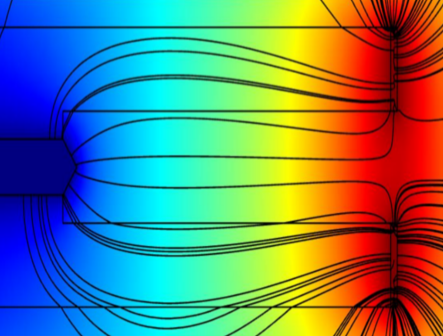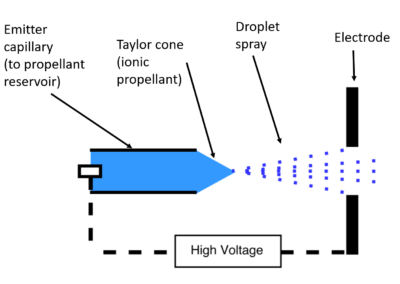Project
Novel Materials for Scaling Electrospray Thruster Arrays
A COMSOL model of electric potential and
streamlines in the extraction region of an electrospray emitter.
project personnel
Collin B. Whittaker
principal investigator
Benjamin Jorns
previous personnel
Pete Dahl, Angela Kimber
affiliated personnel
Henry Sodano
Of all modern electric propulsion devices, electrospray thrusters are particularly attractive as they have the highest power efficiency, a widely throttleable specific impulse and the potential for having the highest thrust density. These thrusters are based on electrospray technology where nano-sized conductive droplets, solvated ions or both, are emitted from a Taylor cone singularity, and accelerated to high velocities through an electrostatic field that is created between an extracting electrode and an ionic liquid emitter. The last decade of research on these colloidal thrusters has been focused on integrating micro- and nanofabrication technology to develop arrays of electrospray emitters. These devices create very precise thrust on the order of ~10uN, and have been demonstrated to work with high (90%) electric conversion efficiency. The ability to reliably and optimally scale electrospray arrays in size could fundamentally advance space flight technology and in principle, electrospray arrays could go beyond micropropulsion applications to high-powered (>50kW) interplanetary human exploration mission objectives.
Despite the progression in fabrication techniques and electrospray thruster development, attempts at scaled-up arrays are stymied by alignment and manufacturing tolerance issues, leading to chemical degradation and arcing incidents. In partnership with the Materials Science Engineering Department, PEPL is investigating the use of a combination of novel materials and new architectures to attempt to scale these devices in size by incorporating new ‘self-healing’ flexible polymers and conductive materials that could mitigate such limitations and lead to the development of large-scale electrospray thrusters for high performance, deep-space missions.
Exploratory efforts using commercial electromagnetic software are used to numerically validate how the use of new materials and geometries affect the electric field, as well as the voltage required to maintain the Taylor instability and create a monodisperse, consistent electrospray of droplets or ions. Once numerical simulations confirm that the design and emitter materials support operation of the thruster, experimental verification of the results will commence later this year.
Selected Publications
Dielectric Materials with Deposited Electrode Layers for Electrospray Arrays
Kimber, A., Jorns, B., and Sodano H.
Data-Driven Scaling Laws for Electrospray Plume Divergence from a Capillary Tube
Dahl, P.N., Kimber, A.M., and Jorns, B.
Uncertainty Quantification of Electrospray Thruster Array Lifetime
Jorns, B.A., Gorodetsky, A., Lasky, I., Kimber, A., Dahl, P., St. Peter, A., and Dressler, R.
Future Directions for Electric Propulsion Research
Dale, Ethan; Jorns, Benjamin; Gallimore, Alec
Quantifying Uncertainty in the Scaling Laws of Porous Electrospray Emitters
Collin B. Whittaker , Alex Gorodetsky and Benjamin Jorns
Robust Design of Electrospray Emitters
Alex A. Gorodetsky, Collin B. Whittaker, Audelia Szulman and Benjamin Jorns
Model Inference from Electrospray Thruster Array Tests
Collin B. Whittaker, Alex A. Gorodetsky and Benjamin A. Jorns



